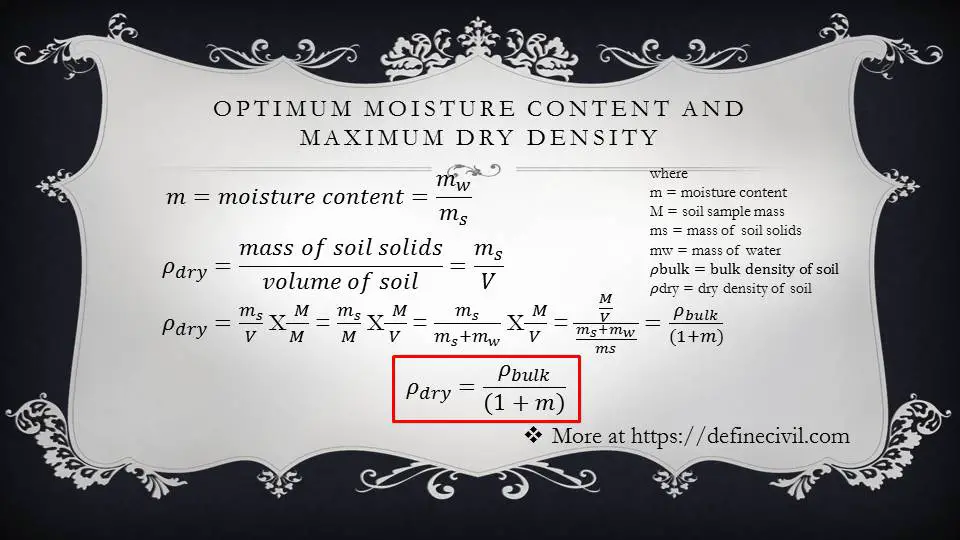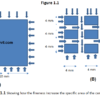Dry density is an important concept in geotechnical engineering. When you’re in the field for soil compaction, you need to know the parameters that affect the dry density of soil. You might also be looking for related terms like dry unit weight of soil, bulk density of soil, or density of soil solids.
Definition of dry density
We can define the dry density of soil as:
“Dry density is an empirical value that specifies the density of soil in dry state”
or
“Dry density is the density of soil solids”
Use of dry density of soil in the field
Engineers undertake various methods of compaction in the field. The main aim of all such methods is to improve the dry density of soil. By using soil compactors, we attempt to keep the soil particles close together and compress.

Dry density and moisture content
We use the concept of maximum dry density to compare the density of soil achieved at field. With such, for soils supporting the building foundation of a building, experts recommend the field density to be 95% of maximum dry density.
However, we can only achieve maximum compaction or density of soil by using a certain value of moisture content. Engineer’s term this moisture content as optimum moisture content.
The relationship between density of soil and moisture content is direct upto a maximum value. After that the density reduces because of the opening of soil particles.
So, let’s now discuss how we can determine the dry density of soil. I would also explain how to establish a relationship between dry density and moisture content of soil.
Let’s delve in.
Moisture content – dry density relationship
A soil in bulk state has three components. Soil solids are enclosed with voids that have water and air inside. As a result of compaction, the air and water is expelled creating a compressed or compacted matrix.
With such, we can define moisture content of soil as:
“The ratio of mass of water to the mass of soil solids in a sample is known as the moisture content of a soil”
We can express the moisture content by m. Such that:
m = mass of water / mass of soil solids = mw / ms
Now, we can express the dry density as
Ddry = mass of soil solids / total volume of soil = Ms / V
So, the dry density is the ratio between the mass of soil solids to that of the total volume of the soil.
Now in laboratory, it is impossible to determine the mass of soil solids only. So, the we need to modify the above equation into parameters that are easy to find in the laboratory.
For that, let’s multiply the above equation with mass of soil sample (M). This is the bulk mass of soil sample.
Ddry (dry density of soil) = (Ms / V ) x (M / M)
Now by slightly re-arranging the above equation we can separate (M/V) as the bulk density of soil sample.
So,
Ddry (dry density of soil) = (Ms /M ) x (M / V)
Now, we know the mass of soil sample is the mass of soil solids and the mass of water in the voids.
With such, M = Ms + Mw
Now;
Ddry (dry density of soil) = (Ms /(Ms+Mw) ) x (M / V)
by rearranging
Ddry (dry density of soil) = (M / V) / ((Ms+Mw )/Ms )
as M/V = bulk density of soil or Dbulk so,
Ddry (dry density of soil) = (Dbulk) / (1+m )
Hence, to obtain dry density of soil, we just need the bulk density of soil and the water content of the soil sample. You can obtain Bulk density of soil by different methods of field density test like sand cone method and core-cutter method.

How moisture content affects the dry density?
Do you know the behavior of soil when we add water in it?
Soil particles in dry state are not easy to compact. The soil solids are stiff and due to friction you can’t easily compact them. They will become stiff along with crack and gaps inside.
But when you add water, it lubricates the soil solids. The thin water film helps keep the particles to contact with each other.
Thus, with water you can easily compact the oil. With such, the soil becomes denser under compaction.
But this process of densification goes on till a limit. At one point, on our way, the volume of air in the soil reduces and thus the dry density becomes maximum.
The water content at this stage is termed as the Optimum Moisture Content. The density at OMC is termed as maximum dry density or MDD.
What is optimum moisture content?
In the laboratory we can obtained the maximum dry density with standard proctor test and modified proctor test. As a result of these tests, we can plot a graph showing relationship between moisture content and the dry density.
We plot moisture content on x-axis while dry density on y-axis. Such a typical graph is shown in the picture below.

If you add water beyond the optimum moisture content, the water will occupy extra space and thus reduce density. You can see the compact curve for the relationship between optimum moisture content and dry density of soil.
Importance of Optimum Moisture Content
As you know we want to achieve maximum dry density in the field that is close to the density we determined in the laboratory. So, the only way of doing such is to apply the optimum moisture content to the soil. For example, we prepare a base or a sub-base for an asphaltic pavement. You can’t achieve or come close to the maximum dry density value, unless you apply optimum moisture to the pavement layer.
A soil stays in different states due to the presence of water content in it. These states are defined as atterberg limit. The concept of atterberg limits like liquid and plastic limit would further help you in this concept.
In most of the standards, you need to achieve minimum of 95% to 98% of the maximum dry density in the field. If you can’t achieve the percentages, you can’t have your reach certified by the engineer.
We can obtain optimum moisture content in the laboratory by standard and modified proctor compaction test. These tests are standard tests that are used to determine the optimum moisture content at which the dry weight of the soil is greatest.
Range of Optimum Moisture content
| Soil | Optimum moisture content for compaction (range in %) |
| Inorganic silt, clayey silt | 24 – 12 |
| Inorganic clay | 24 – 12 |
| Organic silt | 33 – 21 |
| Inorganic clay, highly plastic | 36 – 19 |
What is compaction curve?
I’ve used the word “compaction curve” in the previous paragraph. So, what actually is a compaction curve?
Well, compaction curve is a graph plotted by taking moisture content on x-axis and dry density on y-axis. We just collect the soil sample from the field and perform compaction tests in the laboratory (standard proctor test and modified proctor test). We then use the results of the laboratory test to plot a graph.
[su_box title=”Recommended Read for you” box_color=”#0092c4″ radius=”9″ id=”social_definecivil”][su_posts template=”templates/list-loop.php” tax_term=”21″ order=”desc”][/su_box]

















